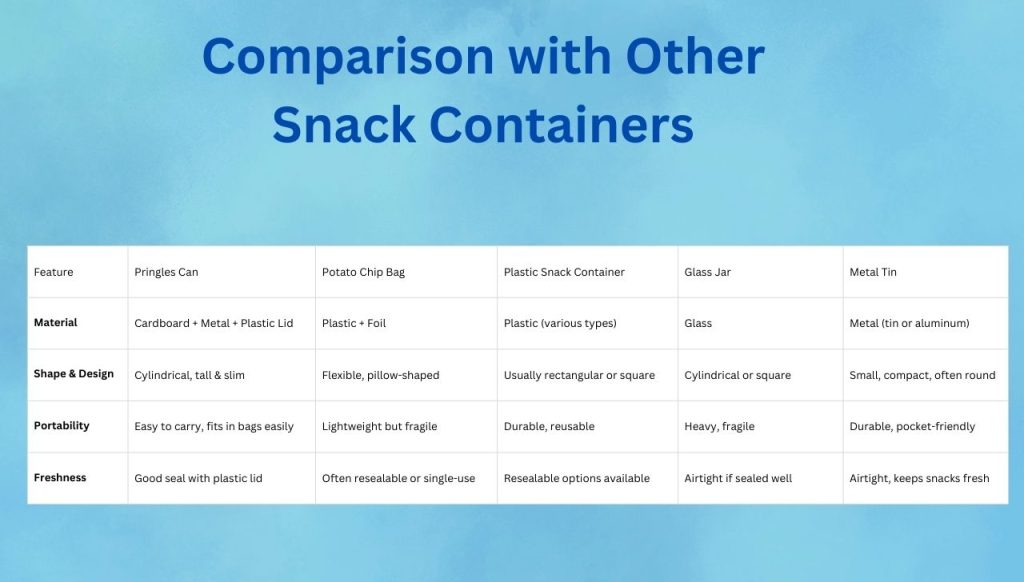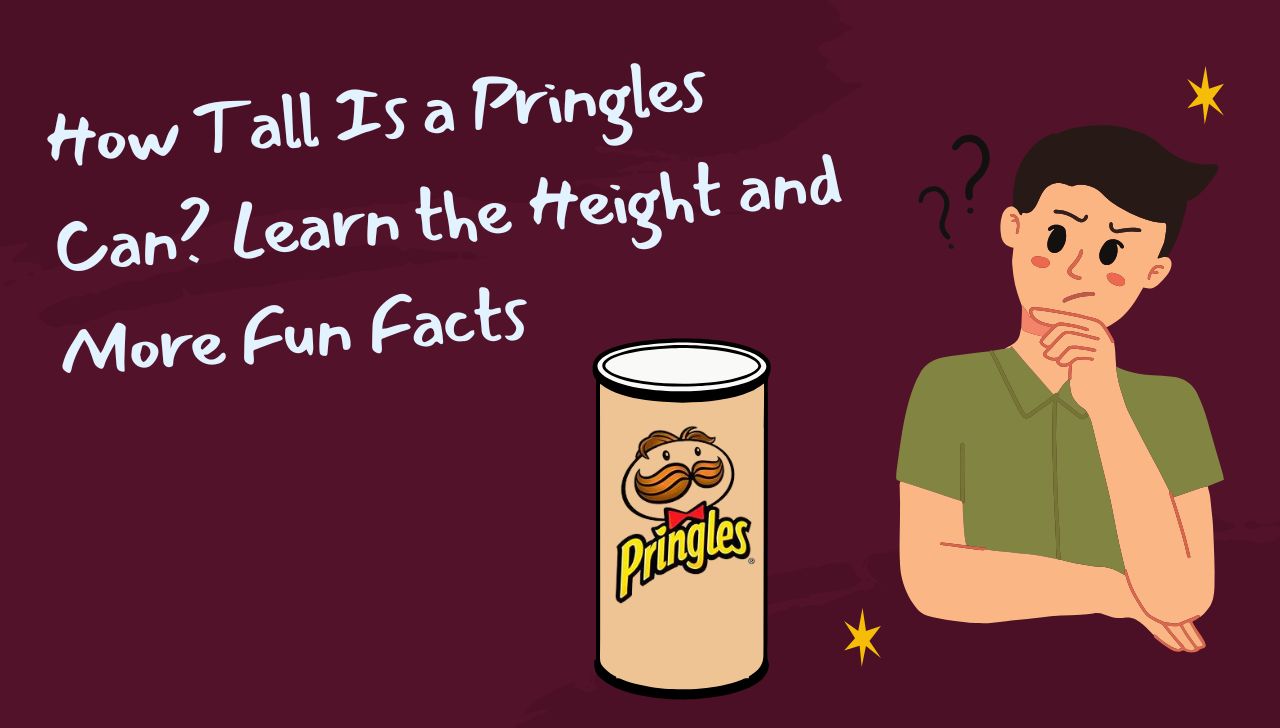Have you ever stared at a Pringles can and wondered, just how tall is it? It’s one of those everyday things that sneaks under our radar until curiosity hits. While it might seem like a simple question, the height of a Pringles can varies a bit depending on the size you grab at the store. But that’s not all—there’s more to these iconic curved chips and their packaging than meets the eye. Stick around, and you’ll learn the exact measurements plus some quirky fun facts about those colorful cylinders that hold your favorite snack.
History and Design of the Pringles Can
The History Behind the Pringles Can
Pringles were introduced by Procter & Gamble back in 1968. Before that, most chips were just tossed into bags—often ending up crushed and broken by the time you got to them. If you’ve ever opened a bag and found mostly crumbs, you know what I mean. That frustration was exactly the problem Pringles aimed to fix.
The solution? A tall, tubular can that would keep each chip intact and fresh. Not only that, but the unique saddle-shaped chip design—called a “hyperbolic paraboloid”—was developed so the crisps would stack perfectly and resist breakage. A fancy name, sure, but basically it means the chip’s shape distributes pressure evenly, so they don’t snap easily. Clever, huh?
The Design: More Than Just a Tube
At first glance, the Pringles can might look like a simple cardboard tube with a plastic lid, but it’s a little engineering marvel. The tube is made from multiple layers: cardboard for sturdiness, a thin metal layer for freshness, and an inner foil lining to lock in that crisp flavor. This layered construction keeps air and moisture out, which is critical for a snack that’s all about the crunch.
Plus, the shape itself is efficient — it’s tall and narrow, making it easier to stack on shelves and less prone to getting squashed in transit. And that round lid? It snaps on and off easily, unlike typical chip bags that you have to fold and try to reseal.
How the Pringles Can Keeps Chips Fresh
Ah, the classic Pringles can — you’ve probably wondered how this simple-looking container keeps those chips so fresh and crunchy, right? It’s a neat mix of clever design and innovative materials that work together to protect the chips inside. Let me explain.
First, unlike traditional potato chip bags that puff up and sometimes crush the chips inside, the Pringles can is a rigid cylinder made from a cardboard combo and a thin metal bottom, topped with a plastic lid. That structure alone means the chips aren’t squished when stacked or tossed around. Think of it like a tiny fortress for your chips—no crushing, no crumbling.
But here’s the real kicker: it’s all about controlling air and moisture. Potato chips are dehydrated, super-crispy snacks that hate humidity. A little moisture, and suddenly, you’re stuck with soggy chips instead of that perfect crunch. The can’s material, especially the foil lining inside, is a barrier that keeps moisture and oxygen out. That’s crucial because oxygen can make the oils in chips go rancid and cause stale flavors.
Creative DIY Projects with a Pringles Can
1. Stylish Desk Organizer
Picture this: a cluttered desk with pens, pencils, scissors, and random stationery everywhere. Enter the Pringles can—wrap it in patterned paper or fabric, or give it a sleek coat of spray paint. Suddenly, you have a neat, vertical organizer for all those writing tools. Bonus points if you glue a few cans together side-by-side for a multi-compartment caddy.
2. Mini Planter with a Twist
Yes, you can grow herbs or succulents in a Pringles can. Line the inside with a plastic bag (poke a few drainage holes!), add soil, and plant away. It’s perfect for a windowsill garden that doesn’t take up much space. It’s a quirky conversation starter when you tell people your basil lives in a chip tube.
3. Portable Speaker Amplifier
Here’s something techy yet simple: use an empty Pringles can to amplify your phone’s sound. Cut a slot wide enough for your phone to fit snugly, place the phone with the speaker facing the can’s opening, and voila! It’s like a little megaphone for your tunes, no batteries required. It might not replace your Bluetooth speaker, but it’s a fun hack.
4. Gift Box with a Pop
Gift wrapping can be a pain, right? Instead of hunting for the perfect box, use a Pringles can for small gifts—think jewelry, rolled-up scarves, or even sweets. Decorate the can with wrapping paper or washi tape, tie a ribbon around it, and have a quirky, unexpected gift container that’s sure to impress.
5. Bird Feeder on the Fly
For nature lovers, this one’s a gem. Cut holes near the bottom of the can, fill it with birdseed, and hang it outside with a string through the lid. The narrow shape protects the seed from rain, and the birds get a new feeding spot. It’s an easy way to invite some feathered friends to your yard.
6. DIY Kaleidoscope
Here’s where things get a little magical. Using a Pringles can as the body, add a few small mirrors or reflective materials inside, plus some colored beads or sequins in a sealed transparent cap at one end. When you peek through and rotate it, you get mesmerizing patterns of light and color. It’s a perfect mix of simple physics and creative fun.
Technical Specifications of Pringles Can
Dimensions & Shape:
A standard Pringles can is a cylindrical tube — usually about 7.5 to 8 inches tall and roughly 2.75 to 3 inches in diameter. This shape isn’t random; the cylinder allows those saddle-shaped crisps to stack neatly without breaking, unlike your typical bag of chips. The curve of each chip fits snugly against the next, maximizing space and minimizing crumbs.
Materials:
The can is a combo of cardboard, a thin metal base, and a foil or plastic lining inside. Here’s why that matters:
- The cardboard outer shell offers structural strength but keeps the can lightweight.
- The metal bottom adds sturdiness so it doesn’t collapse when you hold or stack them.
- The foil/plastic lining inside keeps the chips fresh by blocking moisture and air, which is crucial since chips go stale fast if exposed.
Cap:
On top, you get a resealable plastic lid—usually made from polypropylene (PP)—that snaps on tight. It’s designed for easy removal and to keep air out once you’ve popped the seal. It’s small, simple, but it plays a massive role in the snack’s shelf life once opened.
Volume & Capacity:
The can holds roughly 5.5 to 6 ounces (156 to 170 grams) of chips, depending on the product variety and region. The internal volume is optimized so you get a neat stack, with minimal wasted space—because no one likes half-empty packaging.

Comparison with Other Snack Containers
Here’s a detailed comparison table of Pringles cans versus other common snack containers, focusing on factors like design, portability, freshness, durability, and environmental impact. I’ll also follow it up with a quick breakdown to give you the gist.
| Feature | Pringles Can | Potato Chip Bag | Plastic Snack Container | Glass Jar | Metal Tin |
|---|---|---|---|---|---|
| Material | Cardboard + Metal + Plastic Lid | Plastic + Foil | Plastic (various types) | Glass | Metal (tin or aluminum) |
| Shape & Design | Cylindrical, tall & slim | Flexible, pillow-shaped | Usually rectangular or square | Cylindrical or square | Small, compact, often round |
| Portability | Easy to carry, fits in bags easily | Lightweight but fragile | Durable, reusable | Heavy, fragile | Durable, pocket-friendly |
| Freshness | Good seal with plastic lid | Often resealable or single-use | Resealable options available | Airtight if sealed well | Airtight, keeps snacks fresh |
| Protection | Protects chips from breakage | Chips can get crushed easily | Good protection from crushing | Excellent protection | Excellent protection |
| Reusability | Limited (can be reused but not common) | Usually single-use | High – reusable & washable | High – reusable & washable | High – reusable |
| Environmental Impact | Mixed materials complicate recycling | Usually not recyclable | Depends on plastic type | Highly recyclable | Usually recyclable |
| Snack Visibility | Opaque – no view of contents | Opaque or transparent | Often transparent | Transparent | Usually opaque |
| Storage Efficiency | Stacks well, takes vertical space | Irregular shape | Stackable and space-efficient | Bulky and fragile | Compact and stackable |
| Cost to Produce | Moderate – multi-material | Low-cost | Variable | High-cost | Moderate to high |
| Common Snacks | Potato chips, crisps | Chips, nuts, candies | Nuts, fruits, trail mix | Premium snacks, pickles | Specialty snacks, mints |
Conclusion:
So, next time you pick up a Pringles can, you’ll know exactly how tall it stands. But beyond just height, these cans carry a legacy of clever design and snack-time joy. Whether you’re stacking them for fun or just reaching in for a chip, there’s a little more to these cans than you thought. Who knew a simple snack container could be so interesting?

Suzana explores how culture, geography, and tradition influence the sizes of everyday items—from clothing to furniture. With international research experience, he brings global perspective to Sizello’s content.


Leave a Reply